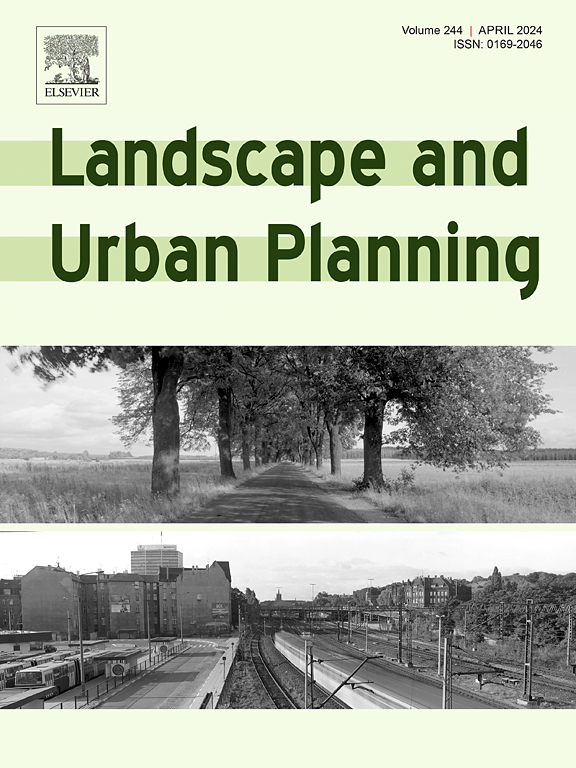The role of urban amenities in facilitating social mixing: Evidence from Stockholm
IF 7.9
1区 环境科学与生态学
Q1 ECOLOGY
引用次数: 0
Abstract
Though the existence of socioeconomic segregation in social interactions has been consistently documented and compared across cities in a growing body of literature, less attention has been paid to within-city analysis of the types of places at which particularly integrated or segregated interactions occur. Dependencies between socioeconomic profile, residential location, preferences and behavior make this kind of analysis difficult. Further, beyond understanding where diverse social interactions take place, it is important to know whether increasing access to those types of spaces via changes to the transportation network can actually increase the level of diversity in social interactions—a more causal question that remains relatively unexplored in the literature. This study presents new perspectives on analyzing social mixing and socioeconomic integration in cities using geolocated cellphone data. Using a call detail record dataset which describes the movements of over one million cell phone users in Stockholm, Sweden, this study quantifies the contribution of access to various types of urban amenities to one’s exposure to people with diverse income levels. Our results provide evidence that areas of the city with more libraries, educational institutions, healthcare establishments, parks and restaurants host more exposures between people who are different from one another in terms of income. Further, we leverage random shocks to the transportation network that come from maintenance-based road closures to identify a causal relationship between access to parks, services and healthcare establishments and experienced income diversity. Temporary, random increases in travel times to these spaces due to road closures result in less diverse day-to-day encounters for urban residents.
城市设施在促进社会融合方面的作用:斯德哥尔摩的证据
尽管在越来越多的文献中,社会经济隔离在社会交往中的存在被不断地记录下来,并在不同城市之间进行比较,但对于城市内部发生特别融合或隔离交往的场所类型的分析却关注较少。社会经济状况、居住地点、偏好和行为之间的依赖关系使得这种分析变得困难。此外,除了了解多样化社会交往的发生地之外,还必须了解通过改变交通网络来增加进入这些类型空间的机会,是否能够真正提高社会交往的多样性水平--这是一个更具因果关系的问题,但在文献中仍相对缺乏研究。本研究提出了利用地理定位手机数据分析城市社会混合和社会经济融合的新视角。本研究利用描述瑞典斯德哥尔摩 100 多万手机用户移动情况的通话详细记录数据集,量化了获得各类城市便利设施对接触不同收入水平人群的贡献。我们的研究结果表明,在城市中拥有较多图书馆、教育机构、医疗机构、公园和餐馆的地区,收入不同的人之间的接触机会更多。此外,我们还利用因道路封闭维修而对交通网络造成的随机冲击,确定了公园、服务机构和医疗机构的使用与收入多样性之间的因果关系。由于道路封闭,前往这些场所的旅行时间会临时、随机地增加,从而导致城市居民的日常接触多样性降低。
本文章由计算机程序翻译,如有差异,请以英文原文为准。
求助全文
约1分钟内获得全文
求助全文
来源期刊

Landscape and Urban Planning
环境科学-生态学
CiteScore
15.20
自引率
6.60%
发文量
232
审稿时长
6 months
期刊介绍:
Landscape and Urban Planning is an international journal that aims to enhance our understanding of landscapes and promote sustainable solutions for landscape change. The journal focuses on landscapes as complex social-ecological systems that encompass various spatial and temporal dimensions. These landscapes possess aesthetic, natural, and cultural qualities that are valued by individuals in different ways, leading to actions that alter the landscape. With increasing urbanization and the need for ecological and cultural sensitivity at various scales, a multidisciplinary approach is necessary to comprehend and align social and ecological values for landscape sustainability. The journal believes that combining landscape science with planning and design can yield positive outcomes for both people and nature.
 求助内容:
求助内容: 应助结果提醒方式:
应助结果提醒方式:


